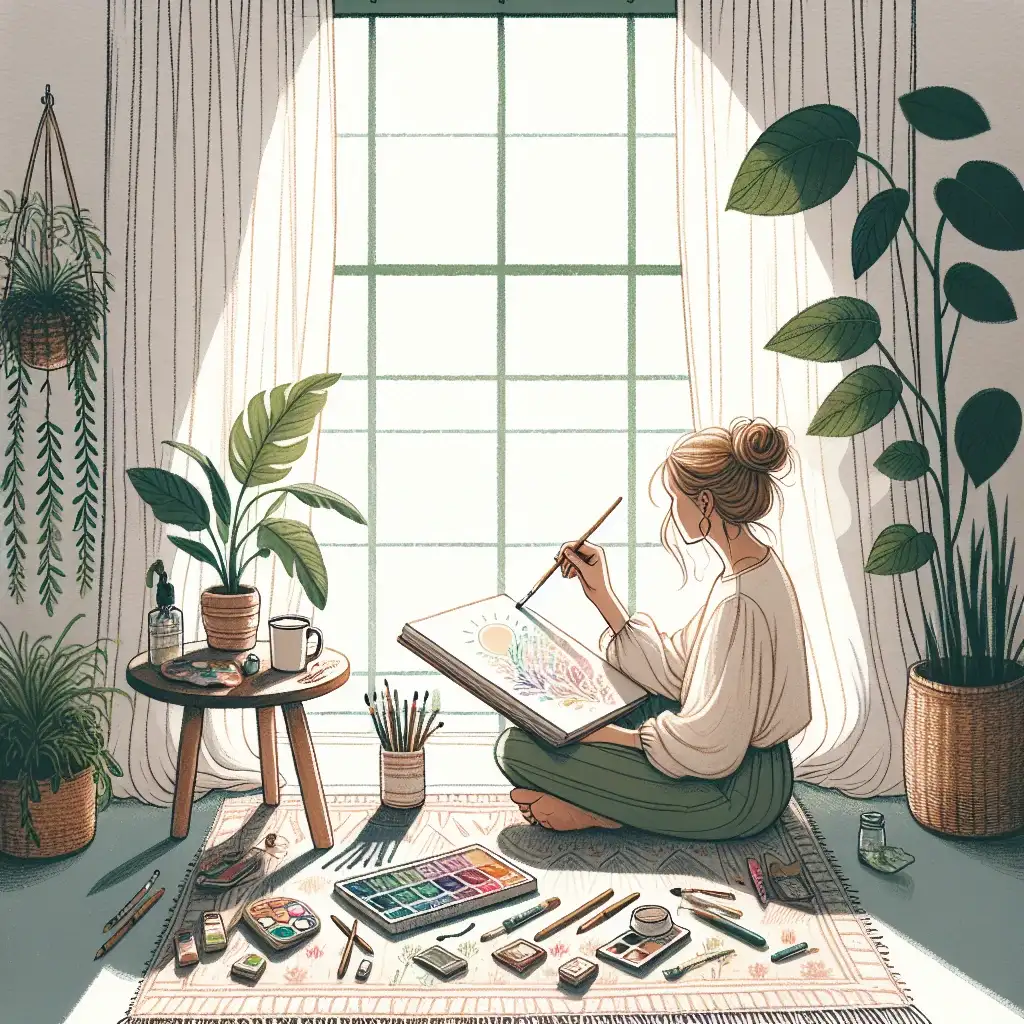Have you ever wondered how a simple art journal can transform your mental state and overall well-being? Surprisingly, research indicates that engaging your creativity can lower stress levels and improve emotional resilience. By diving into the world of mindfulness art journaling, you can unlock not only a creative outlet but also a pathway to deeper self-discovery and tranquility.
Creating a mindfulness art journal is about more than just putting pen to paper. It’s an invitation to cultivate awareness and presence through the transformative power of art. Picture a serene space where you can hone in on your feelings and explore your thoughts without judgment. This journey encourages you to embrace your creative instincts, turning them into visual expressions that reflect your experiences.
Imagine allowing your emotions to flow freely onto the page as you explore various mediums and techniques. Your art journal becomes a sanctuary for your thoughts, feelings, and aspirations—a safe space where you can uncover insights about yourself. Whether you choose to sketch, paint, or collage, the process fosters a sense of calm and focus, enhancing your mindfulness practice.
Ready to embark on this enriching journey? Let’s explore step-by-step how to elevate your mindfulness through the art of journaling!
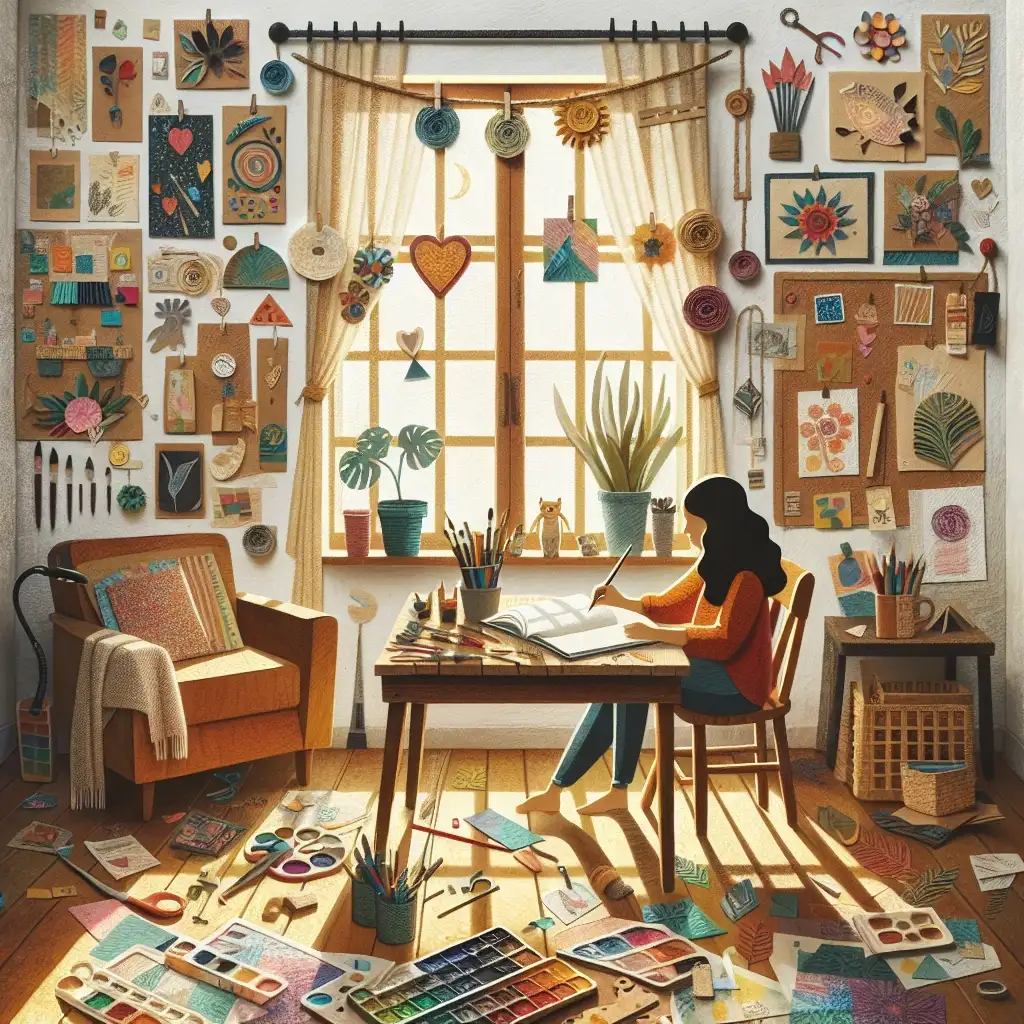
Choose a quiet and comfortable spot
Find a space that feels inviting and peaceful to you. This could be a cozy corner of your room, a favorite chair, or even a spot in your garden. Ensure the area allows you to focus without interruptions. A comfortable environment sets the tone for mindfulness, enhancing your creativity and introspection.
Gather all necessary art supplies
Collect all the materials you will need for your art journaling. This can include colored pencils, paints, brushes, or just plain paper and a pen. Having everything in one place maximizes your creativity and minimizes distractions, giving you the freedom to express yourself fully.
Set aside a specific journal
Choose a beautiful journal that resonates with you personally. This could be a simple notebook or a specially designed art journal. Setting aside a specific journal not only gives you a dedicated space for your thoughts and creativity but also encourages routine practice, reinforcing your mindfulness journey.
Create a calming atmosphere
Enhance the ambiance of your space by incorporating soft lighting or candles. Natural light from a nearby window can also create a soothing environment. Consider playing soft, calming music or using essential oils to further enrich your sensory experience, inviting you to dive deeper into your art practice.
Remove potential distractions
Take a moment to minimize any distractions in your environment. Silence your phone, close unnecessary tabs on your computer, and inform others that you need some quiet time. By consciously removing distractions, you allow your mind to become more focused and present, making space for more genuine creativity and reflection.
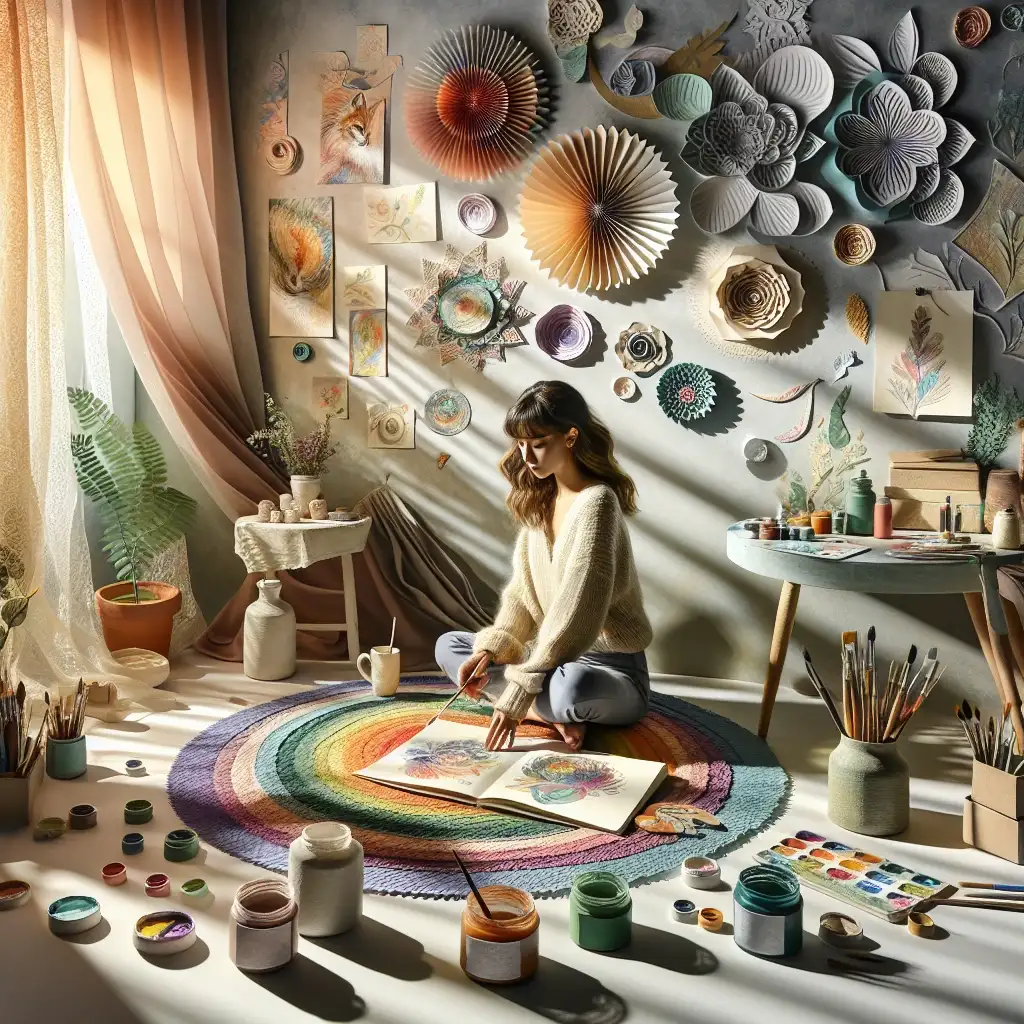
Practice deep and focused breathing
Start by finding a quiet space where you can sit comfortably. Take a moment to close your eyes and draw in a deep breath through your nose, allowing your lungs to fill completely. Hold that breath for a moment, then softly exhale through your mouth. Repeat this process several times, letting each breath become deeper and more intentional, clearing your mind of distractions.
Begin with a brief meditation
Once you’ve settled into your breathing, take a few minutes to meditate. Focus on your breath and gently acknowledge any thoughts that arise without judgment, allowing them to pass like clouds in the sky. This meditation will prepare your mind for creativity, fostering a sense of calm and presence that will enhance your artistic expression. A peaceful mind leads to a freer, more authentic art experience.
Visualize your art before starting
Take a moment to imagine the piece you want to create. Picture the colors, shapes, and feelings you wish to convey through your art. This visualization sets a clear intention for your work, which can guide your creative process and keep you focused on what truly matters to you during this mindful journey.
Engage all senses during creation
As you begin to create, allow yourself to engage fully with your surroundings. Notice the feel of the paint on your brush or the texture of the paper beneath your fingers. Incorporating sensory experiences like the sounds of your tools or the smell of the materials can enhance your focus and deepen your connection to the art-making process.
Stay present and in the moment
Throughout your art-making session, remind yourself to stay in the present. If your mind starts to wander, gently guide it back to the sensations you’re experiencing and the actions you’re taking. By anchoring yourself in the moment, you allow your creativity to flow freely without the burden of judgment or expectation. This dedication to presence enriches your artistic expression and overall mental well-being.

Reflect on your day's highlights and feelings
Take a few moments at the end of each day to think about what stood out to you. Consider the highlights, whether they are small victories or memorable interactions. Journaling your thoughts can help you connect with your emotions. Write about what made you feel happy, anxious, or grateful - this will provide a rich foundation for your art.
Snapshot moments into quick sketches
Grab a sketchbook and keep it close at hand. When inspiration strikes, quickly jot down simple sketches that capture the essence of your day, no matter how rough. These quick drawings don't have to be perfect; focus on capturing the feeling. This helps you remember moments that might fade with time and sparks your creativity for future art.
Translate emotions into colors and shapes
Once you've reflected and sketched, it's time to choose your colors. Think about the emotions associated with the events of your day, and find shades that resonate with them. Use shapes to symbolize your experiences – circles for happiness, jagged edges for frustration. Let your feelings guide your artistic choices to create a visual representation of your day.
Gather elements from nature and surroundings
Take a walk and collect natural materials like leaves, flowers, or small stones. These elements can add a unique texture and dimension to your journal. Incorporating these pieces into your artwork not only enhances the aesthetic but also connects you more deeply with your environment, reinforcing the mindfulness aspect of your journaling.
Appreciate art in everyday life
Make a habit of noticing beauty around you – from a striking sunset to an interesting street pattern. This mindfulness will feed into your art journal, inspiring new themes and ideas. By embracing art in the mundane, you'll enrich your creative process. Each day will become an opportunity to find new inspiration, pushing the boundaries of what you consider art.
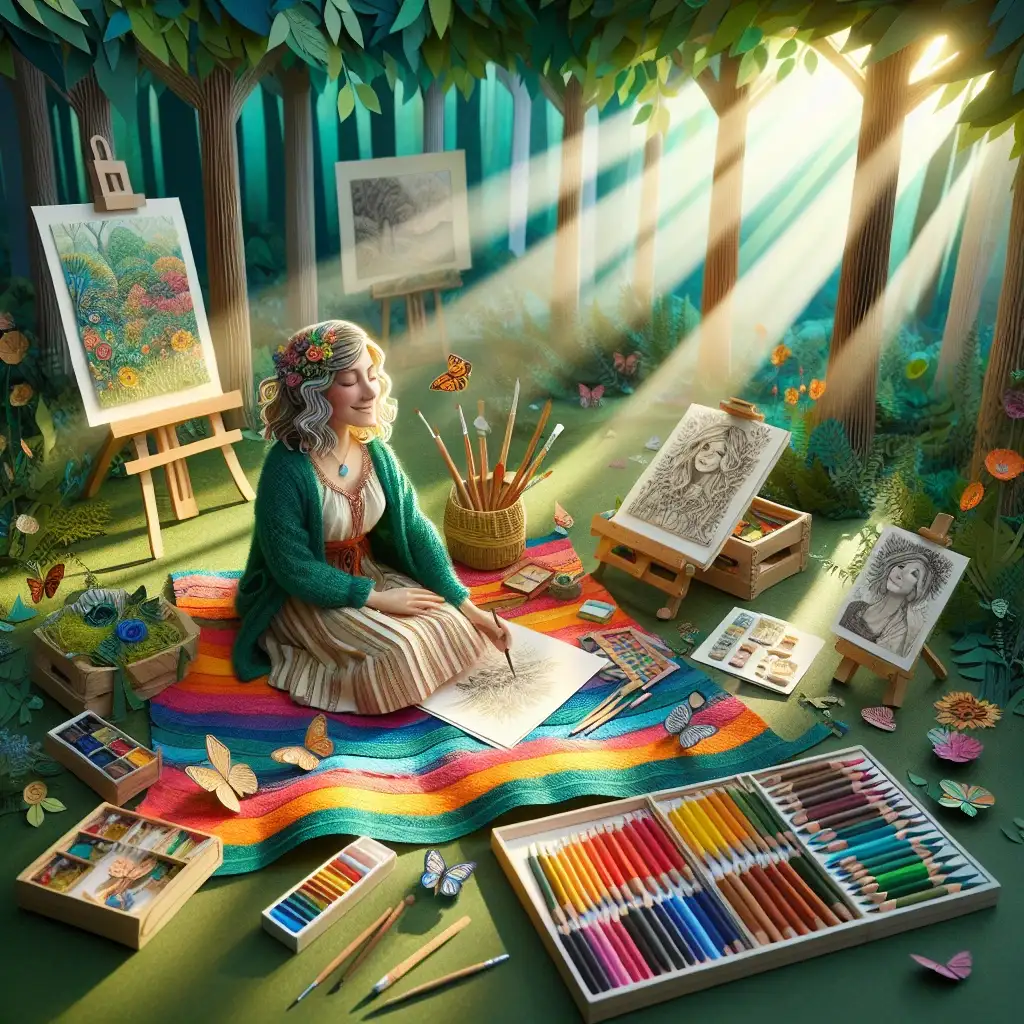
Explore watercolors for a fluid expression
Watercolors offer a unique and fluid medium that allows for spontaneous creativity. Embrace the unpredictability of this medium by simply letting the paint flow on the paper, allowing you to express your emotional state in every brushstroke. Choose vibrant colors that resonate with your mood or select calming hues to reflect tranquility. This exploration not only enhances your artistic skills but also deepens your mindfulness practice as you focus on the movement of the paint.
Try collage for mixed media effects
Collage lets you combine various materials and textures, which can be a fantastic way to express complex thoughts and feelings. Collect images, textures, and words from magazines or your own photographs to create a narrative that speaks to you. As you layer and arrange these pieces, pay close attention to your thoughts and emotions that arise. This process encourages you to reflect on how different elements interact, fostering a deeper connection with your art and yourself.
Use pens and markers for bold lines
Pens and markers can infuse your art with energy and clarity through bold lines and intricate details. Get lost in the drawing process by doodling or sketching freely, allowing your creativity to flow without the pressure of perfection. Experiment with different line weights and styles to convey various emotions. As you work with these tools, stay present with each stroke, turning your doodles into a mindfulness practice where each line becomes a reflection of your inner thoughts.
Incorporate found objects into your work
Using found objects can add a three-dimensional aspect to your journal, making it feel more personal and connected to your environment. Gather items like leaves, fabric scraps, or even small trinkets that resonate with your artistic intention, and glue them into your pages. This tactile approach not only enhances the visual impact of your art but also encourages you to engage with your surroundings. As you add these elements, reflect on the memories or stories each item evokes, capturing the essence of your mindfulness journey.
Play with digital tools or apps
Digital art tools and apps can offer endless possibilities for creation and exploration. Experimenting with software allows you to manipulate colors, shapes, and layers effortlessly, providing an exciting platform to express your thoughts and feelings in new ways. Don’t be afraid to combine traditional and digital methods to create unique pieces. Embrace the innovative aspects of technology in your art practice, inviting a modern twist into your mindfulness journey and expanding your creative boundaries.
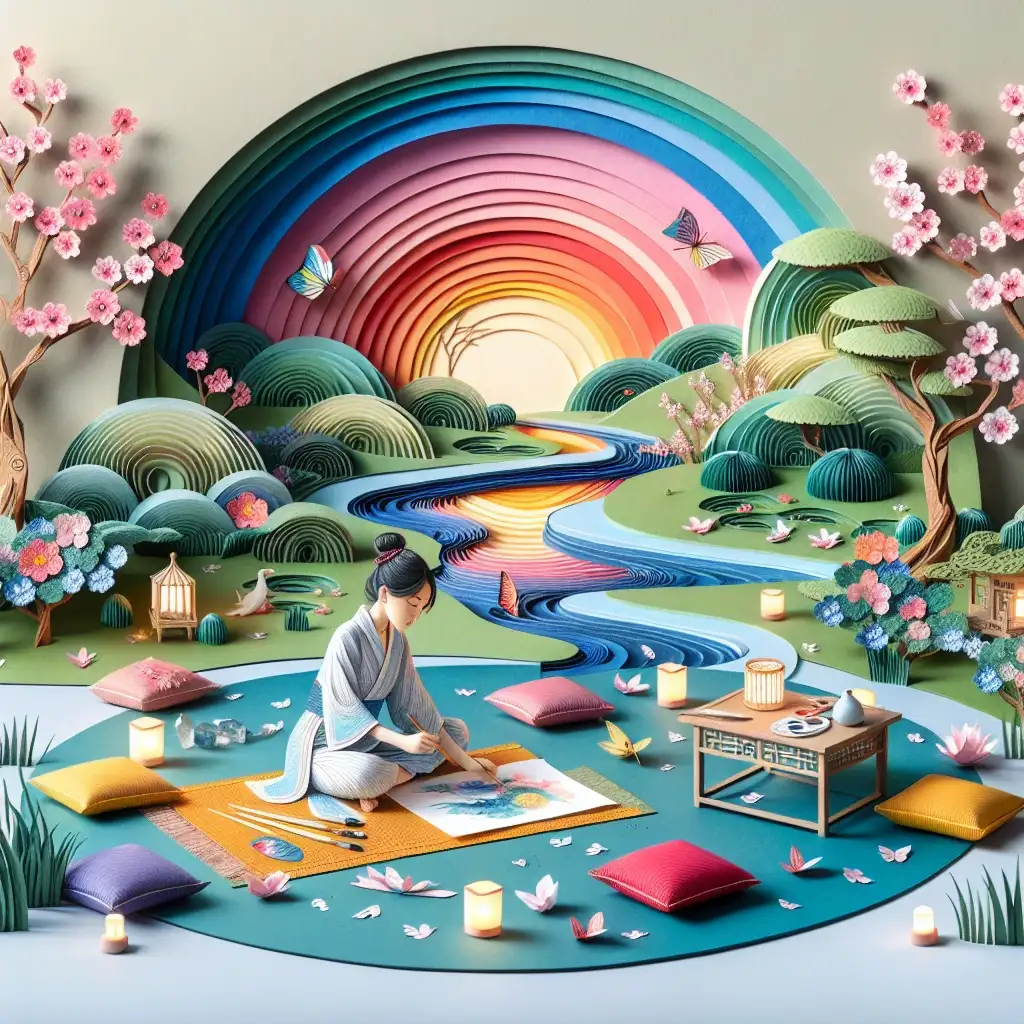
Set a regular journaling schedule
Establish a specific day and time each week dedicated to your mindfulness art journaling. Consistency is key in developing a habit and deepening your mindfulness practice. Consider your daily routine and choose a time when you can be free from distractions. Whether it's early morning or before bed, find what works best for you.
Start sessions with a grounding ritual
Begin each journaling session with a brief grounding ritual. This could be as simple as taking a few deep breaths or lighting a candle to create a serene atmosphere. Incorporate elements that resonate with you, like soft music or a calming scent. This sets the tone for a focused and mindful journaling experience.
Engage in positive affirmations
Before diving into your art, take a moment to reaffirm your intentions. Write down or say aloud positive affirmations that resonate with your artistic goals and personal growth. Affirmations help create a positive mindset, allowing you to embrace creativity and self-acceptance. Remind yourself that your art is a reflection of your unique expression.
Conclude with reflection and gratitude
At the end of each session, spend a few moments reflecting on your experience. What emotions did you feel while creating? What insights did your art bring? Follow this with an expression of gratitude—acknowledge the time you took for yourself and the creative journey. This acts as a positive reinforcement for your mindfulness practice.
Review progress weekly for growth
Set aside time each week to review your art journal and reflect on your progress. Look for patterns in your thoughts and emotions expressed through your art. This practice not only tracks your growth but also deepens your understanding of yourself. Celebrate your achievements, no matter how small, and adjust your goals for the upcoming sessions.
As you embark on the journey of mindfulness art journaling, remember that there’s no right or wrong way to express yourself. Embrace the process, allowing your creativity to flourish without self-judgment. Each stroke of color or paper collage invites you deeper into your own emotional landscape.
Creating a dedicated space makes all the difference. Let it be your sanctuary, a realm where your thoughts flow freely. Transform mundane moments into vivid memories through simple sketches or vibrant colors, and carry these joys into your pages.
Incorporating mindfulness techniques can enhance your experience significantly. Each breath you take should be a reminder of the present moment, helping you connect authentically with your feelings. Whether you engage in meditation before creating or simply focus on the sensations of your art tools, these small habits can bring about profound shifts.
Experimenting with various art mediums is your playground for discovery. Dive into the fluidity of watercolors or the intricacies of doodling with pens. Your journal can evolve into a testament of your emotions, growth, and resilience.
So, gather your supplies and allow your creativity to run wild! Remember, every entry is a step toward a clearer, calmer mind. As you journal, you’ll not only find artistic expression but also deepen your journey of self-discovery and peace. Let the adventure begin!
